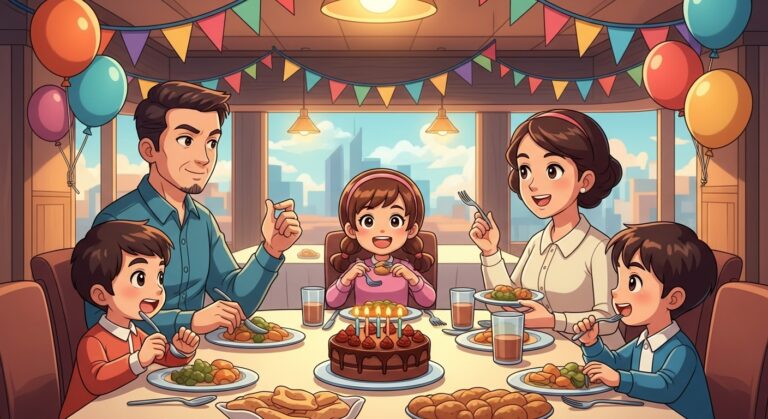The Birthday Lunch Dilemma
It was a bright Saturday afternoon when the sun cast a warm glow over the bustling city. The kind of day that beckons families out of their homes and into the embrace of cheerful eateries. On this particular day, the air was filled with laughter and chatter as families gathered to celebrate a special occasion—the birthday of my mother-in-law, a woman known for her love of family gatherings and delicious food.
As we arrived at the restaurant, the vibrant decorations and the inviting aroma of grilled meats and freshly baked bread greeted us. My husband, our two children—nine-year-old Jamie and four-year-old Lucy—and I were among the first to arrive. We were soon joined by my sister-in-law, Sarah, and her two children. The table was set, and as the chatter of relatives filled the air, I felt a wave of excitement. Birthdays in our family were always filled with joy, laughter, and memorable moments.
As the waiter approached to take our orders, Sarah, with her confident demeanor, spoke up. “Alright, everyone! We’re all going to have the kids’ meal! Chicken tenders and fries for the little ones, and juice, of course!” she declared, her voice ringing with certainty.
I glanced at my children, whose faces lit up at the thought of indulging in crispy chicken tenders, but I knew better. Jamie and Lucy had hearty appetites, and I could already envision the aftermath of their hunger if we settled for the limited kids’ meals. The last thing I wanted was for them to leave the table still feeling hungry and grumpy.
So, when the waiter reached me, I took a deep breath and made my decision. “Actually, my kids will be having adult meals,” I said firmly. I could feel a mixture of relief and defiance wash over me as I watched the waiter jot down their orders. Jamie’s eyes sparkled with excitement at the thought of indulging in a full plate of spaghetti, while Lucy eagerly chose a cheeseburger.
The moment I finished ordering, I felt the tension shift. Sarah’s expression darkened, and I could see the gears turning in her mind. “Seriously? You’re going to let them order adult meals? That’s embarrassing for the kids,” she muttered under her breath, but it was loud enough for a few nearby relatives to hear.
“Why? I’m paying for it,” I replied, trying to keep my tone light.
“They’re kids! They should eat what all the other kids are eating!” she insisted, her voice rising slightly.
I could sense the growing unease at the table. The other adults exchanged glances, unsure of how to navigate this unexpected confrontation. Jamie looked at me, confused, while Lucy clutched her coloring book, oblivious to the brewing storm.
“Sarah, I just want my kids to be satisfied. If they want a meal, they should get it,” I replied, trying to maintain my composure amidst her growing frustration.
The tension hung heavy in the air as the waiter returned with our drinks. I could see Sarah’s kids looking at her, uncertainty clouding their young faces. It was as if they were asking for permission to be upset about not getting the same meal as their cousins. That realization stung. I never intended to create a rift between our kids or embarrass anyone. But I also wasn’t about to let my children go hungry.
As the meals arrived, the table erupted into a cacophony of clinking plates and excited chatter. Jamie dove into his spaghetti with gusto, while Lucy, her burger in hand, giggled as she took a big bite, sauce smearing across her cheek. The joy on my children’s faces made my heart swell. I felt a sense of victory; they were happy and satisfied.
However, Sarah remained visibly upset. The tension at the table was palpable, and I could sense that the festive mood was starting to wane. I looked at her, and for a moment, I saw the frustration in her eyes. “You could have just gone along with what I said,” she snapped.
“I didn’t mean to upset anyone, Sarah. I just want what’s best for my kids,” I replied, my tone softening. “I thought we were all here to celebrate and enjoy ourselves.”
Looking around the table, I noticed that the other family members had begun to shift their focus away from us, trying to maintain the festive atmosphere. It struck me that perhaps we were both acting out of a desire to protect our children, but we were doing it in completely different ways.
“I get it,” Sarah said, her voice lowering. “But it’s just… it’s how we’ve always done things. I want my kids to feel included.”
“I understand,” I replied. “But my kids have different appetites. This isn’t about excluding anyone; it’s about making sure they’re happy and full.”
For a moment, I could see the tension in her shoulders ease just slightly. Maybe, just maybe, we could find a way to move past this. “How about we let the kids choose their meals next time?” I suggested. “That way, they can feel included, and we can avoid this situation again.”
Sarah nodded, the corners of her mouth lifting into a tentative smile. “Yeah, I think that might work.”
As the meal continued, the atmosphere gradually shifted back to one of laughter and joy. We shared stories, reminiscing about past birthdays and family gatherings. Jamie and Lucy, blissfully unaware of the earlier tension, laughed with their cousins, enjoying their meals and the celebration.
By the time dessert arrived—a spectacular chocolate cake adorned with candles—the earlier conflict felt like a distant memory. We all joined in singing happy birthday, the sound echoing throughout the restaurant.
As we savored the rich cake, I exchanged a knowing smile with Sarah. Sometimes, family gatherings could be tricky, but they also presented opportunities for understanding and growth. In that moment, I realized that while our methods of parenting might differ, our love for our children united us.
In the end, the birthday lunch became more than just a meal; it was a reminder that family, with all its quirks and challenges, is worth celebrating—even if it comes with a side of chicken tenders.
—
###





0 Comments